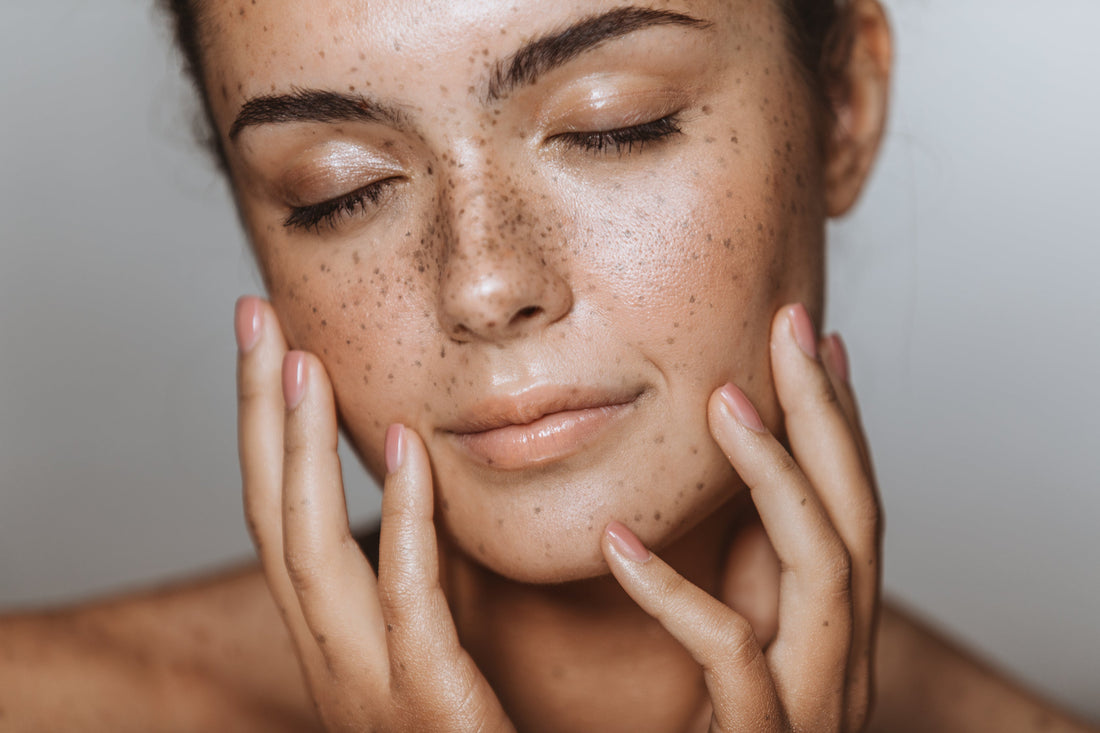
Can You Use Vitamin C With Tretinoin To Improve Skin Tone And Texture?
Written by Dr Shamsa Kanwal - Dermatologist
Updated on March 17th 2025
Are you dealing with dark spots, uneven skin tone, or rough texture? Many skincare enthusiasts turn to Vitamin C and Tretinoin for a brighter, smoother complexion. But can you use Vitamin C with tretinoin safely in the same routine? While some claim this combination enhances skin benefits, others find it too harsh.
In this article, we’ll explore how these ingredients work, whether they can be used together, and the best practices for minimizing irritation while maximizing results.
Understanding Vitamin C And Tretinoin
Before deciding if you should use these ingredients together, let’s break down their individual benefits and effects on the skin.
What is Vitamin C?
Vitamin C, also known as ascorbic acid, is a powerful antioxidant that protects the skin from free radicals [1]. Free radicals are unstable molecules caused by pollution, UV rays, and stress, which lead to premature aging and dull skin [2]. Vitamin C also plays a key role in collagen production and helps reduce the appearance of dark spots and uneven skin tone [3].
Benefits of Vitamin C
-
Brightens Skin Tone: Helps reduce dullness and promotes a more radiant complexion [4].
-
Fades Hyperpigmentation: Minimizes dark spots, sun damage, and post-inflammatory marks.
-
Boosts Collagen Production: Supports firmer, more elastic skin [5].
-
Protects Against Environmental Damage: Shields skin from oxidative stress that accelerates aging.
What is Tretinoin?
Tretinoin, a prescription-strength retinoid derived from Vitamin A [6], is widely recognized for its ability to accelerate cell turnover. By increasing skin renewal, it reduces fine lines, unclogs pores, and enhances overall skin texture [7]. However, its potency can cause irritation, especially when combined with other active ingredients like Vitamin C.
Tretinoin is not recommended for individuals with sensitive skin or compromised barriers, as its potency can increase irritation and disrupt skin balance.
Benefits of Tretinoin
-
Speeds Up Cell Turnover: Helps shed dead skin cells and promote new skin growth [8].
-
Reduces Fine Lines and Wrinkles: Stimulates collagen production to improve skin elasticity [9].
-
Unclogs Pores: Effective in treating acne and preventing breakouts [10].
-
Even Skin Texture: Smooths roughness and minimizes surface irregularities.
Due to its potency, Tretinoin can cause dryness, peeling, and irritation, particularly during the initial weeks of use. As a prescription-strength retinoid, it’s essential to introduce it gradually and follow a dermatologist’s guidance to minimize discomfort and achieve optimal results. Additionally, it may not be the best option for sensitive skin as it can trigger irritation and compromise the skin barrier.

Can You Use Vitamin C with Tretinoin?
The combination of Vitamin C and Tretinoin is widely debated. While some dermatologists and skincare enthusiasts praise their combined benefits, others caution against potential irritation. So, can you mix Tretinoin with Vitamin C safely? While using vitamin C with tretinoin is technically safe, we strongly recommend that individuals with sensitive skin or younger users reconsider using Tretinoin altogether. Its long-term effects, including increased sensitivity and irritation, can be concerning even when usedwith the right approach. Instead, opting for gentler, non-irritating alternatives can better support skin health in the longer run.
Why is Mixing Vitamin C with Tretinoin Challenging?
Since skin reactions vary from person to person, understanding the potential drawbacks before incorporating both into your routine is crucial. Some of the disadvantages are explained below:
Risk of Skin Irritation
Both Vitamin C and Tretinoin are potent active ingredients. When used together, they may cause dryness, peeling, or redness, especially for sensitive skin types or beginners.
pH Incompatibility
Vitamin C, particularly in its purest form (L-ascorbic acid), requires a low pH to remain stable and effective, while Tretinoin functions best in a slightly higher, more neutral pH. Applying them together may interfere with their absorption and efficacy.
Increased Sun Sensitivity
Tretinoin makes the skin more sensitive to the sun, increasing the risk of irritation and hyperpigmentation if sunscreen isn’t used. On the other hand, Vitamin C helps protect the skin from UV damage by acting as an antioxidant and combating free radicals generated by UV exposure. However, Vitamin C is not a substitute for sunscreen and does not directly block UV rays. If using Tretinoin, applying sunscreen daily is essential to prevent unwanted side effects.
3 Safe and Effective Ways to Use Vitamin C and Tretinoin Together
Combining Vitamin C and Tretinoin can deliver skin benefits, but improper use may lead to irritation. Since both are potent active ingredients, a strategic approach ensures maximum results without compromising your skin barrier.
While this combination works well for some, those with sensitive or younger skin should consider a gentler routine. Prioritizing soothing, barrier-supportive alternatives can promote long-term skin health without the risk of irritation.
For those who still wish to explore the combination of Vitamin C and Tretinoin, follow these dermatologist-approved methods to know how to layer vitamin C and tretinoin safely without skin irritation.
Option 1: Use Vitamin C in the Morning and Tretinoin at Night (Suitable for most skin types except sensitive skin)
This is the most recommended approach as it prevents interactions between the two ingredients and optimizes their individual benefits. Vitamin C in the morning helps protect the skin from environmental stressors like UV rays and pollution. Tretinoin at night works with the skin’s natural repair process to promote cell turnover.
Morning Routine:
-
Cleanse with a gentle, sulfate-free cleanser.
-
Apply 2-3 drops of Vitamin C serum, pressing it into the skin.
-
Wait 1-2 minutes for absorption.
-
Follow with a moisturizer containing soothing ingredients like PeachCalm and SyriCalm to prevent dryness.
-
Apply broad-spectrum SPF 50 sunscreen—this step is essential as Tretinoin increases sun sensitivity.
Also, be mindful that some hydrating or barrier creams marketed for sensitive skin still contain ingredients that block pores. Always double-check your products with our free checker to spot pore-clogging ingredients in order to keep your skin clear and calm, especially when your barrier is already under stress from strong actives.
Night Routine:
-
If wearing makeup or sunscreen: Double cleanse by using an oil-based cleanser first to dissolve impurities, followed by a gentle water-based cleanser. If using a gel-based cleanser, a separate water-based cleanser is not needed.
-
Apply a hydrating, fragrance-free moisturizer first to create a buffer.
-
Wait 10-15 minutes, then apply a pea-sized amount of Tretinoin to dry skin. However, it's better to use gentler alternatives like peptides and hydrolyzed glycosaminoglycans to help maintain skin health and reduce the risk of future depigmentation.
-
Follow with another layer of moisturizer to minimize dryness.
This method is ideal for beginners, as it allows both ingredients to work effectively without compounding irritation.
Option 2: Use Both at Night With the Buffer Method (Best for users experienced with both ingredients)
If you prefer applying both at night, the buffer method helps minimize irritation while maintaining efficacy. A moisturizer acts as a barrier, reducing direct interaction between Vitamin C and Tretinoin.
Step-by-Step Buffering Method:
-
Cleanse your face and pat dry.
-
Apply Vitamin C serum and allow 20-30 minutes for full absorption.
-
Apply a lightweight moisturizer and wait 10-15 minutes to reduce sensitivity.
-
Apply a pea-sized amount of Tretinoin and spread it evenly.
-
Seal in hydration with another layer of moisturizer.
This method works well for those already accustomed to both ingredients and looking to simplify their routine.
Option 3: Use Gentle Tretinoin Alternatives (Best for sensitive or irritation-prone skin)
If your skin is prone to irritation or redness, avoid Tretinoin entirely and focus on gentler alternatives like peptides and hydrolyzed glycosaminoglycans. These ingredients help support skin renewal while minimizing the risk of sensitivity and long-term depigmentation.
Step-by-Step Gentle Alternative Method:
-
Cleanse your face and pat dry.
-
Apply Vitamin C serum and let it absorb for 20–30 minutes.
-
Apply a moisturizer containing peptides and hydrolyzed glycosaminoglycans to support skin renewal and hydration.
This approach allows the skin to benefit from active ingredients without excessive irritation. Persistent irritation beyond a few weeks should be discussed with a dermatologist.
If you're looking for a Vitamin C serum that supports your skin while using Tretinoin, Rush Hour Serum is a gentle, barrier-friendly option powered by our proprietary GLOW7™ blend. This serum designed for sensitive skin offers gentle, targeted support. It features BV-OSC, a stabilized, non-irritating form of Vitamin C, along with soothing and hydrating actives that help calm sensitivity and reinforce your barrier, an ideal option to reduce the risk of purging when using stronger actives like Tretinoin.
Who Can Use Vitamin C and Tretinoin Together?
Is Vitamin C good with Tretinoin for all skin types? It depends. While some people see great results from using both, others may experience irritation. Here's a quick guide on whether you can use Vitamin C and Tretinoin together according to your skin type:
| Skin Type/Condition | Can Use? | Best Approach |
|---|---|---|
| Normal to Oily Skin | Yes | Vitamin C in the morning, Tretinoin at night with lightweight hydration. |
| Dry Skin | With caution | Use a gentle Vitamin C derivative and low-strength Tretinoin. Layer with Saccharide Isomarate and Glycerin for hydration. |
| Sensitive Skin | No | Tretinoin is not recommended for individuals with sensitive skin. |
| Acne-Prone Skin | No | Vitamin C is a great ingredient for acne-prone skin. Tretinoin is not recommended as it may cause irritation. |
How Do I Know If My Skin is Reacting Badly to Vitamin C and Tretinoin?
Mild irritation is common when mixing vitamin C and tretinoin, especially in the initial weeks. However, certain signs indicate your skin may not be tolerating them well. Some signs of negative reactions are:
Excessive Redness or Burning
A slight tingling from Vitamin C is normal, but if your skin feels hot, inflamed, or painful, it may be too irritated. This can indicate pH imbalance or skin barrier damage.
Severe Dryness and Peeling
Tretinoin increases cell turnover, leading to some dryness and flaking. However, if you experience cracked, extremely flaky, or sensitive skin, it suggests overuse or an impaired skin barrier.
Breakouts or Bumps
Purging (temporary breakouts as skin adjusts) is expected within 4-6 weeks. But if acne worsens beyond 8 weeks or becomes painful, the products may be too strong for your skin.
Increased Sensitivity to Sun
If your skin burns, even with sunscreen, it could be a sign of excessive exfoliation or a weakened barrier. Tretinoin and Vitamin C both increase sun sensitivity, making SPF 50+ essential.
Persistent Stinging or Tightness
A tight or stinging sensation long after application may indicate a compromised moisture barrier. If skin feels uncomfortably tight even after moisturizing, it’s time to adjust your routine.
What to Do If You Experience Irritation?
If you notice redness, dryness, or sensitivity, don’t panic—mild irritation is common when introducing active ingredients. The key is to adjust your routine and support your skin barrier. Consider taking the following actions in case of irritation:
Temporarily Pause Vitamin C and Tretinoin:
Stop using both ingredients for a few days to allow your skin to recover. Avoid exfoliants, AHAs, BHAs, and harsh actives during this period.
Focus on Hydration and Barrier Repair
Use a gentle, fragrance-free moisturizer with barrier-restoring ingredients. Look for SyriCalm, PeachCalm, and Unisooth.
Soothe the Skin
Apply a cold compress or a calming serum with Saccharide Isomerate, SyriCalm, or Peachcalm. Avoid hot water, scrubs, and strong treatments while your skin heals.
Prioritize Sun Protection
Tretinoin makes skin highly UV-sensitive, so applying SPF 50+ daily is non-negotiable.
Consult a Dermatologist
If irritation does not improve within 1-2 weeks or worsens, seek professional advice. A dermatologist can recommend gentler formulations or alternative routines based on your skin type.
How To Reduce Irritation with Gentle Ingredients
Since Vitamin C and Tretinoin can dry and irritate, pairing them with skin-soothing and barrier-repairing ingredients helps restore moisture, reduce inflammation, and improve overall skin tolerance. Here are some of the best options:
SEPIBLISS FEEL
SEPIBLISS FEEL is an innovative soothing ingredient derived from coriander seed oil. It’s designed to reduce sensitivity, calm redness, and reinforce the skin’s defenses against environmental stress.
SHAROHYAL SNAIL VEG
While snail mucin is well-known for its hydrating and repairing properties, SHAROHYAL SNAIL VEG serves as a plant-based alternative that offers deep hydration without clogging pores. Additionally, it provides barrier support for dry and irritated skin and is a vegan-friendly option for soothing and repairing.
Unisooth ST
Unisooth ST is a soothing bioactive complex that helps calm redness, reduce inflammation, and protect against oxidative stress. It’s particularly beneficial for sensitive or irritation-prone skin, including those with rosacea, acne, or post-treatment sensitivity.
PeachCalm
PeachCalm is an antioxidant-rich botanical extract that calms inflammation and reduces redness. It’s beneficial for sensitive skin that reacts to strong actives like Tretinoin and Vitamin C.
Myths and Facts about Vitamin C and Tretinoin

FAQs: Can You Use Vitamin C with Tretinoin?
Here are a few of the most frequently asked questions about combining/ pairing Vitamin C with Tretinoin:
-
Can I use vitamin C and Tretinoin at the same time?
It’s not recommended as both are powerful actives, and layering them can increase irritation, particularly for dry or sensitive skin. A safer approach is to use Vitamin C in the morning for its antioxidant protection and Tretinoin at night for its collagen-boosting effects—maximizing benefits while protecting the skin barrier.
It is better to replace tretinoin with alternatives like peptides and hydrolyzed glycosaminoglycans. These gentler ingredients provide anti-aging benefits without the risk of irritation or barrier damage.
-
How do I know if my skin is reacting badly to Vitamin C and Tretinoin?
Signs of a negative reaction to Vitamin C and Tretinoin include:
-
Redness, burning, or excessive peeling
-
Persistent breakouts beyond 6-8 weeks (beyond normal purging)
-
Severe dryness, flaking, or tightness
If symptoms persist, reduce usage, focus on hydration and barrier repair, and consult a dermatologist if necessary.
-
Why does my skin burn when using Vitamin C and Tretinoin?
A burning sensation may indicate:
-
A compromised skin barrier from overuse or lack of moisture
-
High concentrations of Vitamin C or Tretinoin too early in your routine
-
pH imbalance—applying them together can reduce their effectiveness
Solution: Pause usage, focus on hydrating ingredients like Squalane and SHAROHYAL SNAIL VEG, and reintroduce gradually.
-
Is it better to use Vitamin C and Tretinoin every day or on alternate days?
The best way to use Vitamin C and Tretinoin depends on your skin type and tolerance:
-
Normal to Oily Skin
: Using Vitamin C in the morning and Tretinoin at night daily can work well. Vitamin C brightens the skin and protects against free radicals, while Tretinoin boosts collagen and cell turnover. If irritation occurs, switch to using Tretinoin on alternate nights and focus on hydration. -
Dry Skin
: A gentle Vitamin C derivative like BVOSC is a better choice for the morning. For Tretinoin, start with a low-strength formula (0.025%) and use it only 1–2 times a week. Always apply a hydrating moisturizer with ingredients like Saccharide Isomerate or Glycerin before Tretinoin to reduce dryness. -
Sensitive Skin
: Tretinoin can be too harsh and may worsen redness or irritation. Instead, use gentler alternatives like peptides and hydrolyzed glycosaminoglycans. If you want antioxidant protection, opt for BVOSC, a non-irritating form of Vitamin C, and focus on soothing ingredients like PeachCalm or SEPIBLISS FEEL. -
Acne-Prone Skin
: Vitamin C can help fade post-inflammatory marks, but Tretinoin might trigger irritation, especially if acne is active. Instead of Tretinoin, consider using niacinamide to help with breakouts. Choose a non-comedogenic Vitamin C formula and pair it with a lightweight, oil-free moisturizer.
For all skin types:
-
It's better to use gentler alternatives of Tretinoin like peptides and hydrolyzed glycosaminoglycans to help maintain skin health and reduce the risk of future depigmentation.
-
Always wear SPF 50+, as Tretinoin increases sun sensitivity.
-
If peeling, redness, or burning persists, pause these actives and focus on barrier repair with ceramides or SHAROHYAL SNAIL VEG.
-
Can I use Vitamin C and Tretinoin if I have rosacea or eczema?
If you have rosacea or eczema, you need to be cautious with Vitamin C and Tretinoin, as both can irritate sensitive skin.
For rosacea:
-
Avoid Tretinoin during flare-ups, as it can worsen redness and peeling.
-
Instead of traditional Vitamin C (which can be too harsh), opt for a gentler Vitamin C derivative like BVOSC, which provides antioxidant benefits without irritation.
For eczema:
-
Focus on barrier repair with ingredients like SHAROHYAL SNAIL VEG or ceramides.
-
Avoid Tretinoin, as it can cause excessive dryness and irritation.
-
Use a mild Vitamin C derivative like BVOSC instead of traditional Vitamin C.
In both cases, avoid daily use of actives and prioritize soothing ingredients like PeachCalm or SEPIBLISS FEEL.
Conclusion
Using Vitamin C and Tretinoin together can be effective but a balanced approach is key. To minimize irritation and protect your skin barrier, it is important to start slow by introducing actives gradually. Pairing them with hydrating ingredients like Squalane, PeachCalm, SEPIBLISS FEEL, and SHAROHYAL SNAIL VEG can further enhance their benefits. Additionally, prioritizing sun protection with SPF 50+ is non-negotiable.
By supporting your skin with the right ingredients, you can enjoy the benefits of brighter, smoother, and healthier skin without unnecessary irritation. If you experience persistent redness, peeling, or discomfort, consult a dermatologist for personalized guidance.
References
https://www.longecity.org/forum/topic/24948-antioxidants-used-in-skin-care-formulations/
https://onlinelibrary.wiley.com/doi/abs/10.1155/2012/135206
https://onlinelibrary.wiley.com/doi/abs/10.1111/jocd.13305
https://www.mdpi.com/2076-3921/11/9/1663
https://www.ncbi.nlm.nih.gov/sites/books/NBK557478/
https://www.jaad.org/article/S0190-9622(98)70443-8/abstract
https://link.springer.com/article/10.1007/s40257-024-00893-w
https://onlinelibrary.wiley.com/doi/abs/10.1111/j.1473-2130.2004.00094.x

 Hydration
Hydration
 Soothing
Soothing
 Radiance
Radiance
 Clarity
Clarity









